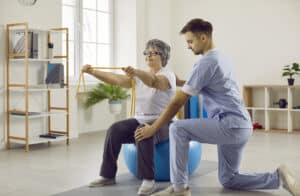
Sarcopenia is a health condition where muscles atrophy to the point that a person experiences extreme loss of function, often requiring home care to manage daily activities. While losing muscle mass with aging is normal, some people experience rapid muscle loss due to other health conditions or lifestyle factors, making it difficult for them to perform basic daily tasks independently.
Sarcopenia can become so severe that living without assistance becomes nearly impossible. Tasks such as climbing stairs, standing up from a chair without assistance, or lifting moderately heavy objects may no longer be feasible. Simple chores like dusting or putting away dishes can leave a person feeling exhausted. Incorporating home care services can provide vital support and ensure safety for individuals with advanced sarcopenia.
If your loved one is at risk for sarcopenia, taking action to prevent further muscle loss is essential. These steps can help maintain their independence and improve their quality of life.
Risk Factors of Sarcopenia
While getting older is the predominant cause of sarcopenia, when it’s combined with other health issues or lifestyle choices, the risk factor will be greatly increased.
- Chronic diseases like chronic obstructive pulmonary disease (COPD), kidney disease, diabetes, cancer, and HIV can increase the speed at which muscles atrophy as a person ages.
- Having diabetes or being insulin resistant.
- Having rheumatoid arthritis
- Being obese
- Living a mostly sedentary life without any regular physical activity
- Not consuming enough essential nutrients to promote healthy muscles, especially protein.
- Being unable to convert protein to energy.
Reducing the Risk of Sarcopenia
While everyone will lose some muscle mass as they age, it’s important for your elderly loved one to take steps now to prevent as much muscle loss as possible. The two biggest factors in reducing the risk of extreme muscle loss are both easy to implement and difficult – increasing physical activity and enjoying a healthy diet.
At first glance, it may seem like these are two simple steps for your loved one to take to reduce her risk of sarcopenia, but sometimes the simplest things can be the most difficult. Changing a lifetime of habits or not knowing where to begin can stop someone like your loved one dead in her tracks, and she may never begin to make the journey toward better health.
A home care provider who works to support your loved one on her new health journey can be the right decision for setting your loved one up for success. With a trained home care provider coming to the home to help her implement healthier food choices by shopping smarter with her and preparing meals ahead of time, your loved one is more likely to succeed.
The second step in reducing the risk of sarcopenia, increasing physical activity, can be easier to implement with the support of a home care team as well. Your loved one’s home care team can help by providing transportation to the senior center for weekly water aerobics classes, joining your loved one on walks through the neighborhood, or helping your loved one find fitness videos to watch and follow along with at home.
Even when changes can make life better, they can be hard to implement, and having support from a home care provider can be the leg up your loved one needs to successfully take the necessary steps to reduce her risk of sarcopenia.
If you or an aging loved one is considering Home Care in San Mateo, CA, please contact the caring staff at Aviva In-Home Care today at (415) 463-1400
Aviva In-Home Care provides exceptional senior home care in the Bay Area, including San Francisco, Burlingame, San Mateo, Hillsborough, Atherton, Menlo Park, Palo Alto, Berkeley, Lafayette, Orinda, and surrounding areas.
- Reducing the Risk of Sarcopenia (muscle loss) in the Elderly - April 22, 2025
- Post-Hospital Care for Seniors: The First 30 Days and Beyond - April 11, 2025
- How Loneliness Can Stress Seniors Out - April 2, 2025



